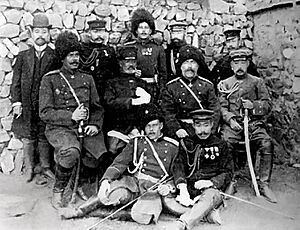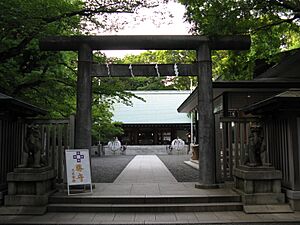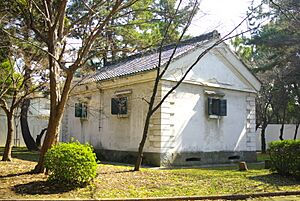Nogi Maresuke facts for kids
Quick facts for kids
Count
Nogi Maresuke
Senior Second Rank
|
|
|---|---|
|
乃木 希典
|
|
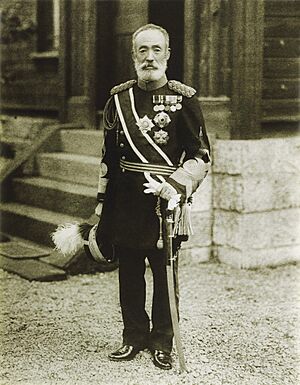
Nogi standing before his house in Nogizaka, Tokyo, shortly before his death in 1912
|
|
| Governor General of Taiwan | |
| In office 14 October 1896 – 26 February 1898 |
|
| Monarch | Meiji |
| Preceded by | Katsura Tarō |
| Succeeded by | Kodama Gentarō |
| Personal details | |
| Born | December 25, 1849 Edo, Japan |
| Died | September 13, 1912 (aged 62) Tokyo, Japan |
| Awards |
|
| Nicknames | Kiten Count Nogi |
| Military service | |
| Allegiance | |
| Branch/service | |
| Years of service | 1871–1908 |
| Rank | |
| Battles/wars |
|
Count Nogi Maresuke (乃木 希典), also known as Kiten, Count Nogi GCB (December 25, 1849 – September 13, 1912), was a Japanese general in the Imperial Japanese Army and a governor-general of Taiwan. He was one of the commanders during the 1894 capture of Port Arthur from China and a prominent figure in the Russo-Japanese War of 1904–05, as commander of the forces which captured Port Arthur from the Russians.
He was a national hero in Imperial Japan as a model of feudal loyalty and self-sacrifice.
Contents
Early life
Nogi Nakito was born on December 25, 1849, at the Chōfu Domain Mansion in Edo (present-day Roppongi, Tokyo), the third son of samurai cavalry officer (umamawari) Nogi Maretsugu and his wife Hisako. His father served the Chōfu Domain, a subsidiary domain of the Chōshū Domain, and held land worth 80 koku. His childhood name was Nakito (無人), literally "no one", to prevent evil spirits from coming to harm him. He was briefly known as Bunzō, after which he was renamed Maresuke. As he claimed descent from the Izumo Minamoto clan through the Sasaki clan, he often used the name Minamoto no Maresuke in his signatures.
Early military career
In November 1869, by the order of the Nagato domain's lord, he enlisted in Fushimi Goshin Heisha (lit. the Fushimi Loyal Guard Barrack) to be trained in the French style for the domanial Army. After completing the training, he was reassigned to the Kawatō Barrack in Kyoto as an instructor, and then as Toyōra domain's Army trainer in charge of coastal defense troops.
In 1871, Nogi was commissioned as a major in the fledgling Imperial Japanese Army. Around this time, he renamed himself Maresuke taking a kanji from the name of his father. In 1875, he became the 14th Infantry Regiment's attaché. The next year (1876), Nogi was named as the Kumamoto regional troop's Staff Officer, and transferred to command the 1st Infantry Regiment, and for his service in the Satsuma Rebellion, against the forces of Saigō Takamori in Kyūshū, he was promoted to lieutenant colonel on April 22, 1877.
On August 27, 1876, Nogi married Shizuko, the fourth daughter of Satsuma samurai Yuji Sadano, who was then 20 years old. As Nogi was 28 years old, it was a very late marriage for that time, considering that the average age to marry was in the early 20s. On August 28, 1877, their first son Katsunori was born, and Nogi bought his first house at Niizakamachi, Akasaka, Tokyo. In 1879, his second son Yasunori was born. He was promoted to colonel on April 29, 1880.
He was posted to Nagoya during the early Meiji era. The warehouse in the Sannomaru enceinte of Nagoya Castle was probably constructed in 1880 (Meiji 13) as an army ammunition depot. It was named later after him.
Promoted major general on May 21, 1885, in 1887 Nogi went to Germany with Kawakami Soroku to study European military strategy and tactics.
In 1894, during the First Sino-Japanese War, Major-General Nogi commanded the First Infantry Brigade which penetrated the Chinese defenses and successfully occupied Port Arthur in only one day of combat. As such, he was a senior commander during the Port Arthur massacre. The following year, he was promoted to lieutenant general (April 29, 1895) and assigned to the Second Division, tasked with the invasion of Taiwan. Nogi remained with the occupation forces in Taiwan until 1898. In 1899, he was recalled to Japan, and placed in command of the newly formed 11th Infantry Brigade, based in Kagawa.
Political career
After the war, he was elevated to danshaku (baron); and he was conferred with the Order of the Golden Kite, 1st class.
Nogi was appointed as the third Japanese Governor-General of Taiwan from October 14, 1896, to February 1898. When moving to Taiwan, he moved his entire family, and during their time in Taiwan, his mother contracted malaria and died. This led Nogi to take measures to improve on the health care infrastructure of the island.
However, unlike many of his contemporaries as officers, Nogi expressed no interest in pursuing politics.
Russo-Japanese War
In 1904, Nogi was recalled to active service on the occasion of the Russo-Japanese War, and was promoted to army general in command of the Japanese Third Army, with an initial strength of approximately 90,000 men and assigned to the capture of the Russian-held Port Arthur on the southern tip of Liaodong Peninsula, Manchuria. Nogi's forces landed shortly after the Battle of Nanshan, in which his eldest son, serving with the Japanese Second Army, was killed. Advancing slowly down the Liaodong Peninsula, Nogi encountered unexpectedly strong resistance, and far more fortifications than he had experienced ten years earlier against the Chinese.
The attack against Port Arthur quickly turned into the lengthy Siege of Port Arthur, an engagement lasting from August 1, 1904, to January 2, 1905, costing the Japanese massive losses. Due to the mounting casualties and failure of Nogi to overcome Port Arthur's defenses, there was mounting pressure within the Japanese government and military to relieve him of command. However, in an unprecedented action, Emperor Meiji spoke out during the Supreme War Council (Japan) meeting, defending Nogi and demanding that he be kept in command.
After the fall of Port Arthur, Nogi was regarded as a national hero. He led his Third Army against the Russian forces at the final Battle of Mukden, ending the land combat phase of operations of the war.
British historian Richard Storry noted that Nogi imposed the best of the Japanese samurai tradition on the men under his command such that "...the conduct of the Japanese during the Russo-Japanese War towards both prisoners and Chinese civilians won the respect, and indeed admiration, of the world".
Both of Nogi's sons-Katsunori (August 28, 1879 – May 27, 1904) and Yasunori (December 16, 1881 – November 30, 1904), who were army lieutenants during the war, were killed in action.
At the end of the war, Nogi made a report directly to Emperor Meiji during a Gozen Kaigi. When explaining battles of the Siege of Port Arthur in detail, he broke down and wept, apologizing for the 56,000 lives lost in that campaign.
Postwar career
After the war, Nogi was elevated to the title of count and awarded the Order of the Rising Sun with Paulownia Flowers, Grand Cordon, 1917.
As head of the Peers' School from 1908 to 1912, he was the mentor of the young Hirohito, and was, perhaps, the most important influence on the life of the future emperor of Japan.
Nogi spent most of his personal fortune on hospitals for wounded soldiers and on memorial monuments erected around the country in commemoration of those killed during the Russo-Japanese War. He also successfully petitioned the Japanese government to erect a Russian-style memorial monument in Port Arthur to the Russian dead of that campaign.
Scouting
Nogi is significant to Scouting in Japan, as in 1911, he went to England in attendance on Prince Higashifushimi Yorihito for the coronation of King George V. The General, as the "Defender of Port Arthur" was introduced to General Robert Baden-Powell, the "Defender of Mafeking", by Lord Kitchener, whose expression "Once a Scout, always a Scout" remains to this day.
Legacy

The epic historical novel Saka no Ue no Kumo portrays Nogi as floundering at the Siege of Port Arthur and having to be relieved by Kodama Gentarō. Several books have been released in recent years rehabilitating Nogi's image and showing he was a competent leader.
The Nogi Warehouse in the Sannomaru enceinte of Nagoya Castle was named after him.
Man of letters
Nogi is also noted in Japan as a man of letters. His Kanshi poems (poems in the Chinese language) were especially popular among the Japanese during his time.
Honors
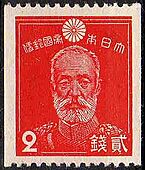
Peerages
- 1895: Baron (August 20)
- 1907: Count (September 21)
Decorations
- 1897: Grand Cordon of the Order of the Sacred Treasure (June 26; Second Class: April 29, 1894)
- 1906: Grand Cordon of the Order of the Golden Kite (April 1) (Third Class: August 20, 1895)
- 1906: Grand Cordon of the Order of the Rising Sun with Paulownia Flowers (April 1). (Second Class: August 20, 1895; Third Class: April 7, 1885)
- 1905: Pour le Mérite (January 10)
- 1907: Grand Cross of the Legion of Honour (April 16)
- 1909: Chilean Gold Medal of Merit (April 28)
- 1911: Grand Cross of the Order of the Star of Romania (October 25)
- 1911: Honorary Knight Grand Cross of the Knights Grand Cross of the Royal Victorian Order (GCVO)
- 1911: Honorary Knight Grand Cross of the Order of the Bath, Military Division (UK) (GCB) (January 1).
Court order of precedence
- 1871: Senior seventh rank (December)
- 1873: Sixth rank (June 25)
- 1879: Senior sixth rank (December 20)
- 1880: Fifth rank (June 8)
- 1885: Senior fifth rank (July 25)
- 1893: Senior fourth rank (April 11)
- 1896: Third rank (December 21)
- 1904: Senior third rank (June 6)
- 1909: Second rank (July 10)
- 1916: Senior second rank (posthumous)
Portrayals
Maresuke was portrayed by Tatsuya Nakadai in the 1980 Japanese war drama film The Battle of Port Arthur (sometimes referred as 203 Kochi). Directed by Toshio Masuda the film depicted the Siege of Port Arthur during the Russo-Japanese War and starred Nakadai as General Maresuke, Tetsurō Tamba as General Kodama Gentarō, and Toshirō Mifune as Emperor Meiji.
In the NHK television adaptation of Ryōtarō Shiba's epic Saka no Ue no Kumo, which aired from 2009 to 2011, Nogi was portrayed by actor Akira Emoto.



